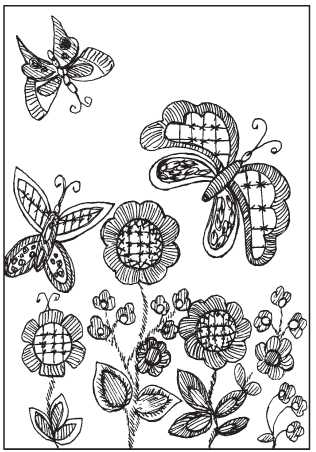You'll need
Batiste white length 75 cm, width 55 cm, thread floss 3-add in white; embroidery needle; diagram of the pattern in full size; water-soluble marker.
Progress
Transfer the pattern on cambric white color with water-soluble marker.
All motives are double-sided satin stitch, knots, gladium roller seams "circle", "goat", "lace", chain stitch, padded satin stitch, patch meshes, loops with pakracani, polypetalae with pakracani. The whole picture is embroidered with white thread in 3 additions.
In any multicolor embroidery should prevail 1 or 2 colors. They are the main determine the overall tone. The other colors just complement them.
The petals of the large flowers complete the double-sided surface. Stitches start in the middle of the flower towards the edge, put should be very close to each other. Highlight the contours of the center of large flowers seam "goat". Pull the needle with the working thread on the front side and put a diagonal stitch on the contour of the mid-down. Simultaneously withdraw the needle there is a little to the left and make a stitch diagonally upwards. Pull the needle from the left side of the stitch. Put the remaining stitches the same way. Then in the middle of an invoice run grid. Put 4 lines of vertical stitches. Over them is put 4 lines of horizontal stitches. Secure the intersections of the strands crosses.
The petals of small flowers embroider by gladium roller. Highlight the contour of midway flowers chain stitch. It is a chain of eyelets facing one another. First, we need to form a loop, then bring the needle with the working thread in the middle of this loop and make another loop. Fill in the middle flowers 3 or 4 knots. Secure the thread to the underside and pull it there. Make around needle 3 turns of thread holding the 1st horizontally over the fabric. Pierce the fabric near the beginning of the stitch and gently pull the thread, tightening the knots simultaneously.
Large leaves complete the satin stitch. First select the outline of the leaf seam "forward needle". Then embroider the leaf stitches bilateral surface. The first stitch is put, beyond the outline of the leaf. Make the next stitch in short, it needs to be inside the loop. The next stitch re-start for the circuit. Thus fill in the entire outline of the leaf stitches of different lengths. Then proceed with the embroidery of the parts of the leaf. Start each stitch in the middle stitch of the 1st row, stepping a little under it. These stitches must be short.
Small leaves embroider a back stitch. What small simple stitches highlight the contour of leaves after each stitch, put the thread on the other side. As a result, the wrong side out eight, and on the front — small stitches around the contour of the leaves.
Embroider the trunk of a large butterfly gladeville stitches, placing them across the body. Head run a loop with pricipal. Bring the needle with the working thread on the front side, form a round loop and finish the stitch at the point where we started. In the middle of the loops, make a tiny tack stitch.
Large wings complete the invoice grid. Route for her 3 lines of simple stitches, first horizontally, then 3 lines vertically. Embroider crosses at the intersections. Edges of large wings select by gladium roller. Each stitch should start from the center towards the edges of the wings.
Little wings complete backing seam, which run in the same way as in the leaves. The inner surface of the fill polypetalae with pakracani. Each of them start in the middle of the wing and place them radiating out of the circle.
The body, medium butterfly, run a stitch "lace". First, make simple stitches along. Then on top of them, run gladeview stitches, placing them across the body. Head embroider the knot. Pull the thread on the front side and obviate it 3 times a needle from left to right.
Then slide the needle near the beginning stitch and pull the thread, tightening the knots.
The upper wings complete patch meshes, edge highlight by gladium roller. The edge of the lower wings embroider satin stitch, the middle and fill with knots.
Torso small butterflies fill polypetalae, having them in one direction. The contours of the upper wings obselite slanted stitches surface. Make a strip of the backing seam and the middle of the wings complete the patch meshes. The contours of the lower wing also complete the oblique surface, and in the middle of embroider knots and circles. The contours of the circles panel seam "forward needle". In the middle make a hole and panel it gladeville stitches (Fig. 69).




